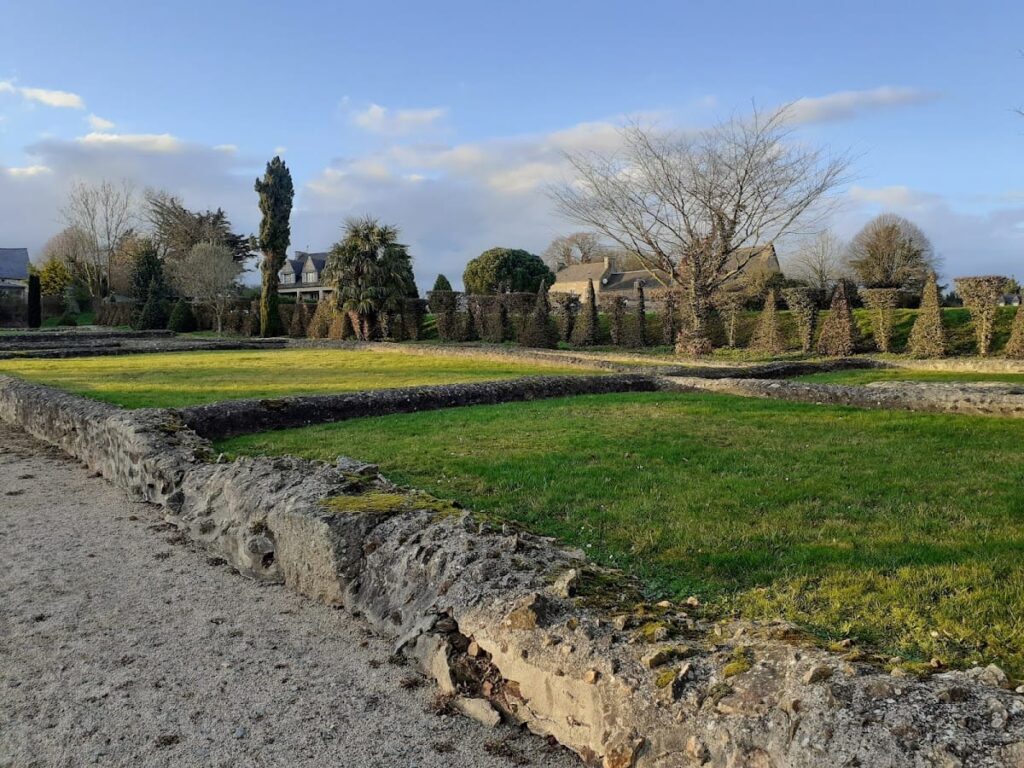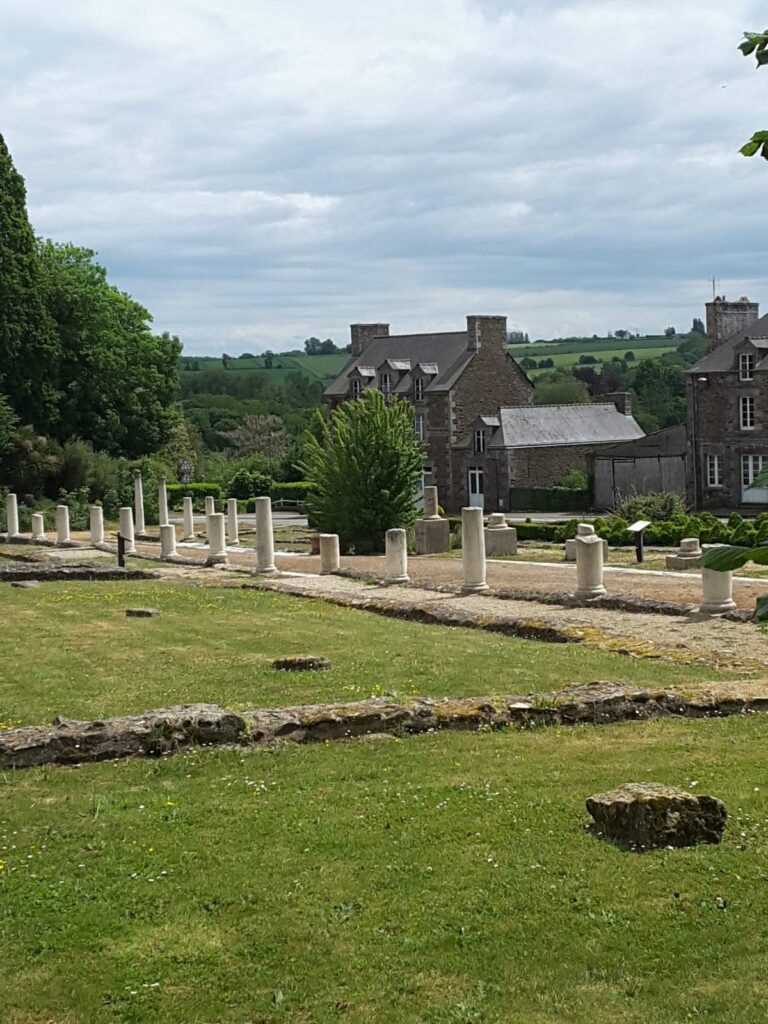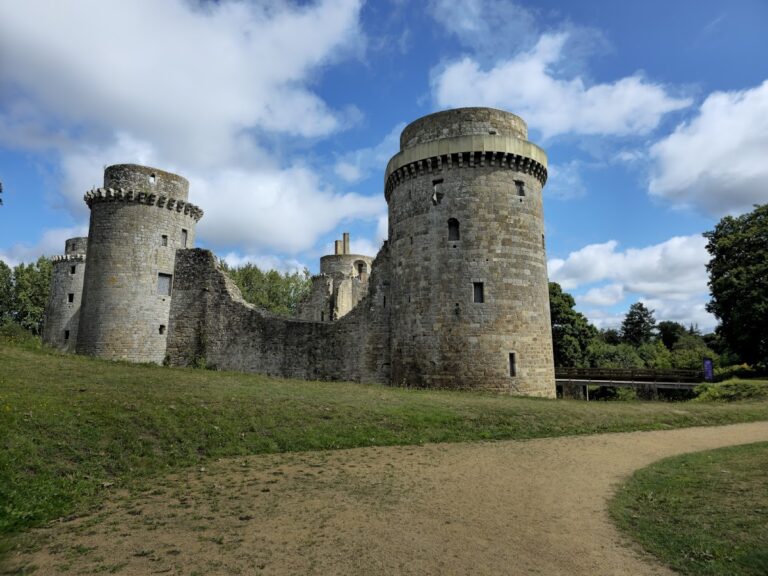Corseul Roman City: Fanum Martis and the Capital of the Coriosolites in Armorica
Table of Contents
Visitor Information
Google Rating: 4.3
Popularity: Low
Google Maps: View on Google Maps
Country: France
Civilization: Celtic, Roman
Remains: Burial, City, Civic, Domestic, Economic, Infrastructure, Religious
Context
The archaeological site of Corseul Roman City, historically known as Fanum Martis, is situated near the contemporary commune of Corseul in the Côtes-d’Armor department of Brittany, northwestern France. It occupies a gently inclined plateau overlooking the valley of the Rance River, providing strategic access to freshwater resources and commanding views of the surrounding landscape. The site lies within the Armorican Massif, a region characterized by a mosaic of mixed forests and agricultural land, which influenced settlement distribution and economic activities during antiquity.
Corseul’s location within this varied topography positioned it as a significant center in the Armorican region, serving as a nexus between inland territories and riverine routes. Archaeological investigations have established that the site was formally established in the 1st century CE as the capital of the Curiosolitae, a local Gallic tribe. Over the 2nd and 3rd centuries CE, Corseul developed under Roman administration, adopting urban planning features typical of Roman civitas centers. The site’s occupation diminished during the late Roman period, with evidence indicating a gradual decline by the 4th century CE. Ongoing archaeological research and conservation efforts by French heritage authorities aim to preserve the extant remains and deepen understanding of the city’s historical trajectory.
History
Corseul, known in antiquity as Fanum Martis, represents a key example of the transformation of a Gallic tribal center into a Roman administrative city within the province of Armorica. Its evolution reflects broader imperial strategies of urbanization and provincial integration in northwestern Gaul. The site’s history spans from prehistoric occupation through late antiquity, illustrating shifts in political authority, religious practices, and urban development.
Late Neolithic to Iron Age
Archaeological evidence attests to human presence at Corseul from the late Neolithic period through the early Bronze Age, indicating a long-standing occupation predating the Iron Age. By the late Iron Age, the site had expanded into an oppidum, serving as the political and economic center of the Coriosolites, a Gallic tribe noted for minting their own coinage. This oppidum functioned as the capital within the civitas framework that structured tribal territories prior to Roman conquest, underscoring Corseul’s regional significance in Armorica during the protohistoric period.
Roman Conquest and Early Imperial Period (1st century BCE – 1st century CE)
The Roman conquest of Gaul, culminating in 52 BCE, brought significant administrative reorganization to the region. Although Julius Caesar mentioned the Coriosolites in his Commentaries, archaeological data do not confirm Corseul as their political center before Roman domination. Under Emperor Augustus, imperial policy mandated the establishment of a new administrative and religious capital within the Coriosolites’ territory, named Fanum Martis, meaning “Temple of Mars.” This foundation represented a deliberate Roman effort to impose provincial governance and religious structures. The city’s initial monumental infrastructure, including its road network, was developed during this period, reflecting Augustan urban planning principles designed to integrate the civitas into the imperial system.
Imperial Roman Period (1st – 3rd centuries CE)
Between the 1st and 3rd centuries CE, Fanum Martis flourished as a Roman civitas, exhibiting a planned urban layout with a grid-patterned street system and insulae (urban blocks). The sanctuary dedicated to Mars, located at the Haut-Bécherel site, was constructed in the mid-1st century CE and remained in use until the late 3rd century. This temple complex, covering nearly one hectare, featured an octagonal cella and substantial masonry walls, of which three sections survive. Residential architecture included domus such as the Clos Mulon house, which belonged to a wealthy local elite and was later augmented with thermal baths, indicating the adoption of Roman domestic and social customs. The Monterfil district yielded fine terra sigillata pottery decorated with intricate motifs, reflecting active artisanal production. A monolithic granite column dedicated to Jupiter, one of only three such monuments in Brittany, was discovered near the modern church, attesting to religious plurality within the city. A Roman road connecting Fanum Martis to Cæsarodunum (modern Tours) facilitated regional integration and trade, remaining in use into the early medieval period.
Late Roman and Early Medieval Period (3rd – early Middle Ages)
From the 3rd century CE onward, Fanum Martis experienced a gradual decline in urban activity, paralleling broader transformations in Roman Gaul. The city’s name shifted to Corseul, reflecting a resurgence of local Gallic identity and a revival of indigenous religious practices, as evidenced by sculptures and inscriptions referencing ancient deities. The funerary complex at Courtil Saint-Antoine, uncovered in 1986, contains graves dating from the late Roman into the early medieval period. These burials, arranged east-west in wooden coffins and sometimes lined with brick walls bearing distinctive marks, illustrate continuity in funerary customs despite urban contraction. No archaeological or historical evidence indicates major military conflicts or natural disasters directly impacting Corseul during this period, suggesting a gradual and peaceful transition marked by social and economic reorganization.
Daily Life and Importance by Period
Roman Conquest and Early Imperial Period (1st century BCE – 1st century CE)
Following the Roman conquest, Corseul was transformed into Fanum Martis, serving as the administrative and religious capital of the Coriosolites within the Roman provincial framework. The population primarily consisted of local Gallic inhabitants adapting to Roman civic structures, alongside Roman officials overseeing governance and cultic activities. Social hierarchies began to align with Roman models, with local elites likely assuming magistracies, although specific individuals remain unidentified. Economic life focused on establishing urban infrastructure, including roads and public buildings, which facilitated administrative control and regional connectivity. Agriculture in the surrounding countryside supported the urban population. Dietary habits likely combined traditional Gallic staples such as cereals and local meats with Roman imports like olive oil and wine, though direct evidence is limited. Religious practices centered on the newly established temple dedicated to Mars, marking a shift from indigenous cults to Roman state religion, with rituals conducted by appointed priests. Early markets and trade networks developed along the newly constructed roads, supporting the city’s administrative and religious functions.
Imperial Roman Period (1st – 3rd centuries CE)
At its zenith, Fanum Martis exhibited a stratified urban society comprising Romanized local elites, artisans, merchants, and laborers. Archaeological and epigraphic evidence indicates that wealthy families resided in domus such as the Clos Mulon residence, which included reception areas for clients and was later expanded with thermal baths, reflecting Roman domestic luxury and social customs. Economic activities were diverse, with artisanal production flourishing, as demonstrated by finely decorated terra sigillata pottery from the Monterfil district. The presence of coin molds and evidence of local minting suggest continued economic autonomy within the Roman system. Agriculture remained foundational, supplemented by trade facilitated by the Roman road linking Fanum Martis to Cæsarodunum, enabling the import of Mediterranean goods. Dietary remains and material culture imply consumption of bread, olives, fish, and locally produced fruits, alongside Roman-style clothing such as tunics and cloaks. Religious life was centered on the worship of Mars, with the large sanctuary at Haut-Bécherel serving as a focal point for public rituals. The discovery of a granite column dedicated to Jupiter indicates religious plurality, integrating Roman and local deities. Civic administration likely involved magistrates overseeing governance, justice, and religious observances. Transportation relied on the well-maintained via romana, supporting movement of people and goods and reinforcing the city’s role as a regional administrative and commercial hub.
Late Roman and Early Medieval Period (3rd – early Middle Ages)
During the late Roman and early medieval periods, Corseul underwent a gradual contraction in urban activity and population, reflecting wider regional transformations. The city’s renaming from Fanum Martis to Corseul signified a reassertion of Gallic identity and a revival of indigenous religious practices alongside residual Roman traditions. The population likely comprised Romanized locals and Gallic descendants, with social structures adapting to diminished civic complexity. Funerary evidence from Courtil Saint-Antoine reveals family-based burial customs, with graves aligned east-west and constructed with wooden coffins and brick-lined walls, indicating continuity of local funerary traditions and possible Christian influence.
Economic activities became more localized and subsistence-oriented, with artisanal production and trade declining but persisting at a reduced scale. The decline in monumental construction and public amenities reflects decreased municipal investment. Dietary and clothing practices likely reverted to simpler forms, relying on local resources, though some Roman influences endured. Religious life became syncretic, combining Christian and revived Gallic cults, as suggested by inscriptions and sculptures referencing ancient deities. Transportation and trade routes remained in limited use, sustaining regional connections but at a reduced intensity. Corseul’s civic role diminished from a Roman civitas to a local settlement maintaining essential administrative and religious functions. The absence of evidence for violent destruction suggests a peaceful transition marked by gradual social and economic reorganization.
Remains
Architectural Features
The Corseul site exhibits a planned urban layout characteristic of Roman civitas centers, with excavations revealing a grid-patterned street system organizing the city into insulae, or urban blocks. Construction predominantly employed local stone masonry, including substantial ashlar work in key structures. The architectural remains encompass religious, domestic, and infrastructural elements, reflecting a mixed civic and residential character. Over time, the urban area contracted, with evidence of reduced building activity and partial abandonment by the 4th century CE. Presently, surviving remains are fragmentary, comprising standing walls, foundations, and subsurface archaeological features.
Key Buildings and Structures
Temple of Mars (Fanum Martis)
The Temple of Mars, situated at the Haut-Bécherel site, was constructed circa the mid-1st century CE and functioned as the principal religious sanctuary until the late 3rd century CE. The temple complex covered nearly one hectare and featured an octagonal cella, a distinctive architectural form. Currently, three wall sections remain standing, each approximately ten meters high, composed of large stone blocks indicative of monumental masonry. The temple’s scale and design reflect its central role in the city’s religious life. The site was designated a French historic monument in 1840 and again in 1997, underscoring its archaeological importance.
Domus of Clos Mulon
Located approximately 100 meters from the city center, the domus at Clos Mulon dates from the 1st century CE and likely belonged to a wealthy local elite during the first three centuries CE. The residence adheres to the city’s grid plan and comprises multiple rooms arranged within an insula. In a subsequent phase, a thermal bath complex was added to the west side of the domus, reflecting the adoption of Roman domestic amenities. Excavations have uncovered the foundations and layout, with a tactile model and explanatory panels in French and Braille available on site to illustrate the structure’s plan and significance.
Domestic Remains at Monterfil
The Monterfil district has yielded archaeological remains of domestic habitation dating to the Gallo-Roman period. Notable finds include fragments of fine terra sigillata pottery decorated with intricate motifs. Two prominent decorative bands depict a hunting scene featuring a human figure with bead-like ornaments, and another portrays a gladiator, deer, and alternating vegetal motifs and rosettes. These artifacts attest to artisanal activity and domestic use within this sector of the city.
Column of Jupiter
A monolithic granite column dedicated to Jupiter was discovered in the mid-19th century near the modern church of Corseul. This Roman-period monument is one of only three such Jupiter-dedicated columns known in Brittany. The column stands 2.07 meters tall and is well preserved except for a minor scratch on the abacus, the flat slab atop the capital. The base comprises a torus molding surmounted by a fillet and an inverted molding. The shaft is short and thick, featuring a twisted motif frieze near its upper section. The capital consists of three stacked registers, with the lowest decorated by truncated collar motifs and the upper two forming a bipartite abacus. This column reflects the religious diversity and syncretism present in the city.
Roman Road and Milestone
Archaeological surveys have identified remains of a Roman road connecting Fanum Martis (Corseul) to Caesarodunum (modern Tours). This route, in use until the early Middle Ages, passed through several settlements including Bazougers, Laval (ancient Vallis Castrum), Saulges, Bazouge-de-Chemeré, Vindunum (Le Mans), and Le Chenu. The road’s construction features typical Roman engineering techniques, including layered surfacing and drainage elements. Milestones and road fragments attest to its maintenance and regional significance during the Roman period, facilitating trade and communication.
Necropolis of Courtil Saint-Antoine
Excavations conducted in 1986 beneath a private residence at Courtil Saint-Antoine uncovered a necropolis comprising 12 individual graves and one collective tomb dating from the late Roman to early medieval periods. The graves are rectangular pits averaging 1.90 meters in length with flat bottoms. Bodies were interred along an east-west axis within wooden coffins, now represented only by iron nails. Some graves feature brick-lined walls bearing distinctive digit marks and incisions, confirmed through archaeometric analysis of seven bricks. These funerary practices illustrate continuity and adaptation of local burial customs during the late Gallo-Roman era.
Other Remains
Additional archaeological prospections have identified multiple domestic habitats (domus) and funerary structures (sepultures) across the site. Numerous artifacts have been recovered, including ceramics, Latin inscriptions, bronze ex-votos such as representations of the god Harpocrates, and coin molds indicative of local minting activities. Surface surveys and preventive excavations in the 1980s revealed important urban structures consistent with the Gallo-Roman period. No architectural remains or significant settlement evidence predating the Roman conquest of 52 BCE have been documented at Corseul.
Archaeological Discoveries
Pottery assemblages at Corseul include fine terra sigillata tableware with richly decorated motifs dating primarily from the 1st to 3rd centuries CE. These ceramics, recovered from domestic quarters such as Monterfil, demonstrate local production with stylistic influences from broader Roman Gaul. Latin inscriptions on stone and bronze artifacts provide fragmentary dedicatory texts associated with religious and civic contexts, naming deities and local officials. Coins from various Roman emperors have been found, indicating economic activity and circulation within the city. Coin molds suggest local coin production. Domestic objects such as lamps and cooking vessels illustrate aspects of daily life during the city’s occupation. Religious artifacts include bronze ex-votos, notably representations of Harpocrates, found near the Temple of Mars and other sanctuaries, dating from the mid-1st to late 3rd centuries CE.
Preservation and Current Status
The Temple of Mars retains three standing wall sections approximately ten meters high, representing the best-preserved monumental structure on site. The foundations of the domus at Clos Mulon have been partially excavated and stabilized, with some areas protected but not reconstructed. The granite column of Jupiter remains intact and preserved in situ near the modern church. Other architectural remains, including domestic ruins and funerary structures, survive mainly as foundations or subsurface features. Many have been stabilized but not restored to their original height or form. Vegetation and erosion present ongoing challenges to preservation, particularly for exposed masonry. Archaeological investigations and conservation efforts are overseen by French heritage authorities, involving preventive excavations, site stabilization, and documentation. Restoration interventions have been limited to structural consolidation, maintaining the authenticity of the ruins.
Unexcavated Areas
Several districts within the ancient city remain unexcavated or only partially studied. Surface surveys and geophysical investigations suggest the presence of buried remains beneath modern fields and urbanized zones, particularly in peripheral areas beyond the known insulae. Some sectors are inaccessible due to private ownership or contemporary development. Future excavations are planned but constrained by conservation policies and land use. Research priorities focus on clarifying the city’s full extent and uncovering additional public and domestic structures. To date, no comprehensive excavation of the entire urban area has been undertaken.









